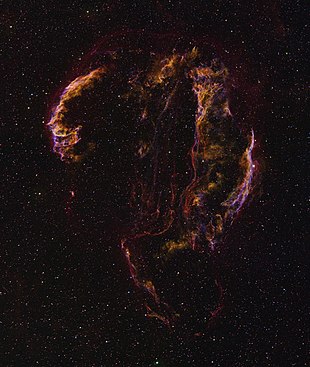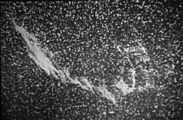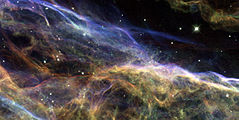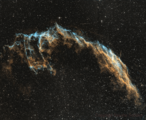Cirrusnebel
| Emissionsnebel | |
|---|---|
| Cirrusnebel (Supernovaüberrest) | |
 | |
| Aufnahme mittels Linienfilter für ionisierte Gase: Hα, SII, OIII Das linke, oberhalb der Mitte befindliche helle Filament wird mit NGC 6992 und 6995 bezeichnet, die angrenzende darunterliegende Struktur mit IC 1340; das rechte helle Filament mit NGC 6960 und der danebenliegende Stern mit 52 Cygni. Die beiden dazwischenliegenden Filamente tragen die Bezeichnung NGC 6974 (oben, mittig) und rechts davon, etwas heller und größer, NGC 6979. | |
| AladinLite | |
| Sternbild | Schwan |
| Position Äquinoktium: J2000.0, Epoche: J2000.0 | |
| Rektaszension | 20h 45m 38,0s[1] |
| Deklination | +30° 42′ 30″[1] |
| Erscheinungsbild | |
| Scheinbare Helligkeit (visuell) | 7.0 mag[2] |
| Winkelausdehnung | 3° |
| Ionisierende Quelle | |
| Physikalische Daten | |
| Entfernung[3] | 2.600 Lj (735 pc) |
| Durchmesser | 150 × 120 Lj[3] |
| Geschichte | |
| Entdeckung | Wilhelm Herschel |
| Datum der Entdeckung | 5. September 1784 |
| Katalogbezeichnungen | |
| NGC 6960, 6974, 6979, 6992, 6995 • IC 1340 • GC 4600, 5975, 4607, 4616, 4618 • H V 15, II 206, V 14 • h 2088, 2092, 2093 • Caldwell 33/34 • Ced 182 | |
Der Cirrusnebel (auch als Schleier-Nebel, englisch Veil nebula bezeichnet) ist der im optischen Spektrum sichtbare Teil des Cygnusbogens, einer Ansammlung von Emissions- und Reflexionsnebeln, die sich in einer Entfernung von rund 2500 Lichtjahren im Sternbild Schwan befinden. Sie sind zusammen der Überrest einer Supernova, die vor ca. 8.000[4] Jahren stattfand.
Übersicht
Diverse Teile des Überrests haben verschiedene NGC- und IC-Nummern. So gehören die Objekte NGC 6960, NGC 6974, NGC 6979, NGC 6992, NGC 6995 und IC 1340 alle zur selben Struktur.
| Name des Objekts | Rektaszension[5] | Deklination[5] | mV | Winkelausdehnung | Entdecker | Entdeckungsdatum |
|---|---|---|---|---|---|---|
| NGC 6960 | 20h 45m 58.2s | +30° 45′ 43″ | 70.00 × 6.0 | Wilhelm Herschel | 7. September 1784[6] | |
| NGC 6974 | 20h 51m 04.3s | +31° 49′ 41″ | Lawrence Parsons | 20. August 1873[7] | ||
| NGC 6979 | 20h 50m 28.0s | +32° 01′ 33″ | 7.00 × 3.0 | Wilhelm Herschel | 7. September 1784[8] | |
| NGC 6992 | 20h 56m 19.1s | +31° 44′ 34″ | 60.00 × 8.0 | Wilhelm Herschel | 5. September 1784[9] | |
| NGC 6995 | 20h 57m 10.7s | +31° 14′ 07″ | 12.00 × 12.0 | John Herschel | 7. September 1825[10] | |
| IC 1340 | 20h 56m 08.2s | +31° 02′ 52″ | 25.00 × 20.0 | Truman Henry Safford | 13. September 1866[11] |
Der Nebel wurde am 5. September 1784 von Wilhelm Herschel entdeckt. Er beschrieb ihn als: „Extended; passes thro' 52 Cygni... near 2 degree in length“; den östlichen Teil als „Branching nebulosity... The following part divides into several streams uniting again towards the south.“
Untersuchungen
Erste Photographien wurden bereits Ende des 19. Jahrhunderts von Isaac Roberts angefertigt und veröffentlicht. Der Nebel ist aber trotz seiner Gesamthelligkeit von circa 7 mag wegen seiner großen Flächenausdehnung von 230′ × 160′ für Amateurastronomen nicht leicht zu beobachten; hilfreich sind kontraststeigernde Nebelfilter. Auf Fotografien, insbesondere im kurzwelligen Spektralbereich, tritt der Nebel deutlich hervor.
- Aufnahme eines Filaments (NGC 6992, 6995) von Roberts mit einem 50-cm-Newton-Teleskop, 1899
- Ultravioletaufnahme mit GALEX
Es wurden und werden an ihm zahlreiche Untersuchungen zur Struktur und Gasdynamik von Supernovaüberresten durchgeführt, beispielsweise Detailstudien mit dem Hubble-Weltraumteleskop. Fotografien in verschiedenen Wellenlängenbereichen, insbesondere auch im Röntgenbereich durch den Satelliten ROSAT, ergeben ein Gesamtbild des Nebels, das in seinen Umrissen an eine Glühbirne erinnert.[12][13] Der kompakte Überrest (Neutronenstern, Pulsar oder Schwarzes Loch) der Supernova ist jedoch nicht bekannt.[14]
- Hubble-Falschfarbenaufnahme mittels mehrerer schmalbandiger Filter (OIII blau; Hα grün; SII rot)
- NGC 6992/6995, Schmalbandaufnahme (HA/OIII) mit einem 16-Zoll-Newton-Teleskop
- (c) ESA/Hubble, CC BY 4.0Detailaufnahme des Hubble-Weltraumteleskops
Trivia
Im Film Dark Star – Finsterer Stern ist der Schleiernebel ein Reiseziel des titelgebenden Raumschiffs.
Literatur
- König, Michael & Binnewies, Stefan (2023): Bildatlas der Sternhaufen & Nebel, Stuttgart: Kosmos, S. 260
Weblinks
- Langbelichtete Amateuraufnahme
- Schmalbandaufnahme (HA/OIII) mit einem 16 Zoll Newton Teleskop
- Spektrum.de: Sammlung von Amateuraufnahmen
- Return to the Veil Nebula (engl.)
Einzelnachweise
- ↑ SIMBAD Astronomical Database. In: Results for Veil Nebula. Abgerufen am 2. Januar 2007.
- ↑ SEDS: NGC 6960
- ↑ a b Robert A. Fesen, Kathryn E. Weil, Ignacio A. Cisneros, William P. Blair, John C. Raymond: The Cygnus Loop's distance, properties, and environment driven morphology. In: Monthly Notices of the Royal Astronomical Society. Band 481, Nr. 2, 2018, S. 1786–1798, doi:10.1093/mnras/sty2370.
- ↑ Revisiting the Veil Nebula. Abgerufen am 6. Juni 2017 (britisches Englisch).
- ↑ a b Searching NED. In: NASA/IPAC EXTRAGALACTIC DATABASE. Abgerufen am 1. Mai 2019 (englisch).
- ↑ Seligman: NGC 6960
- ↑ Seligman: NGC 6974
- ↑ Seligman: NGC 6979
- ↑ Seligman: NGC 6992
- ↑ Seligman: NGC 6995
- ↑ Seligman: IC 1340
- ↑ A High-resolution X-ray Image of the Cygnus Loop. NASA’s High Energy Astrophysic Science Archive Research Center.
- ↑ Veil Nebula (X-rays).
- ↑ B. Uyanıker, W. Reich, A. Yar, R. Kothes, E. Fürst: Is the Cygnus Loop two supernova remnants? bibcode:2002A&A...389L..61U.
- ↑ William P. Blair, Ravi Sankrit, John C. Raymond: Hubble Space Telescope Imaging of the Primary Shock Front in the Cygnus Loop Supernova Remnant. In: The Astronomical Journal. Band 129, 2005, S. 2268–2280, bibcode:2005AJ....129.2268B.
- ↑ Ravi Sankrit, William P. Blair, John C. Raymond, Knox S. Long: Hubble Space Telescope STIS Observations of the Cygnus Loop: Spatial Structure of a Nonradiative Shock. In: The Astronomical Journal. Band 120, 2000, S. 1925–1932, bibcode:2000AJ....120.1925S.
Auf dieser Seite verwendete Medien
Veil nebula or Cygnus loop image through H-alpha, OIII amd SII filter. Background Stars are reduced by subtracting them with images from broader red and green filters. Digital processed.
(c) ESA/Hubble, CC BY 4.0
This Picture of the Week revisits the Veil Nebula, a popular subject for Hubble images! This object was featured in a previous Hubble photo release, but now new processing techniques have been applied, bringing out fine details of the nebula’s delicate threads and filaments of ionised gas.
To create this colourful image, observations taken by Hubble's Wide Field Camera 3 instrument through 5 different filters were used. The new post-processing methods have further enhanced details of emissions from doubly ionised oxygen (seen here in blues), ionised hydrogen and ionised nitrogen (seen here in reds).
The Veil Nebula lies around 2100 light-years from Earth in the constellation of Cygnus (The Swan), making it a relatively close neighbour in astronomical terms. Only a small portion of the nebula was captured in this image.
The Veil Nebula is the visible portion of the nearby Cygnus Loop, a supernova remnant formed roughly 10 000 years ago by the death of a massive star. The Veil Nebula’s progenitor star — which was 20 times the mass of the Sun — lived fast and died young, ending its life in a cataclysmic release of energy. Despite this stellar violence, the shockwaves and debris from the supernova sculpted the Veil Nebula’s delicate tracery of ionised gas — creating a scene of surprising astronomical beauty.Wispy tendrils of hot dust and gas glow brightly in this ultraviolet image of the Cygnus Loop Nebula, taken by NASA’s Galaxy Evolution Explorer. The nebula lies about 1,500 light-years away, and is a supernova remnant, left over from a massive stellar explosion that occurred 5,000-8,000 years ago. The Cygnus Loop extends more than three times the size of the full moon in the night sky, and is tucked next to one of the 'swan’s wings' in the constellation of Cygnus. The filaments of gas and dust visible here in ultraviolet light were heated by the shockwave from the supernova, which is still spreading outward from the original explosion. The original supernova would have been bright enough to be seen clearly from Earth with the naked eye.
A small portion of the Veil Nebula as photographed by the Hubble Space Telescope, showing smoke-like wisps.
Autor/Urheber: Sascha Schueller, Lizenz: CC BY-SA 4.0
BiColor Version of NGC6992.
Red= Hα Green= Hα+OIII light
Blue= OIII lightAutor/Urheber: Roberto Mura, Lizenz: CC BY-SA 3.0
Caldwell Catalogue objects.
Portion of the Veil Nebula as photographed by the Hubble Space Telescope.
Data Description: The Hubble image was created from HST data from proposals 5774 and 5779: J. Hester (Arizona State Universitry) and J. Westphal (Caltech).
Instrument: WFPC2
Exposure Date(s): November 1994, August 1997
Color: This image is a composite of many separate exposures made by the WFPC2 instrument on the Hubble Space Telescope. Three filters were used to sample narrow wavelength ranges. The color results from assigning different hues (colors) to each monochromatic image. In this case, the assigned colors are:
F502N ([O III]) blue
F656N (Halpha) green
F673N ([S II]) red


![Filament, an dem Geschwindigkeit[15] und ionisierte Gase (OV, NV, CIV, HeII)[16] untersucht wurden.](http://upload.wikimedia.org/wikipedia/commons/thumb/0/00/Smoke-like_wisps_in_the_Veil_Nebula_by_HST.jpg/242px-Smoke-like_wisps_in_the_Veil_Nebula_by_HST.jpg)










